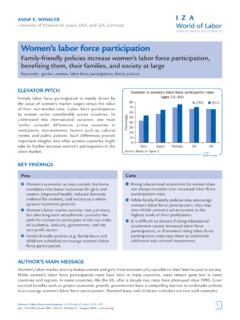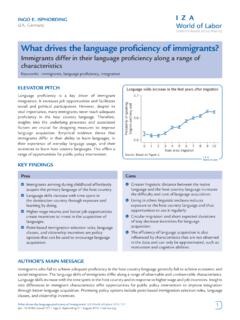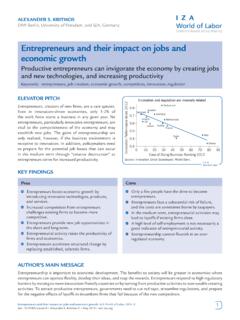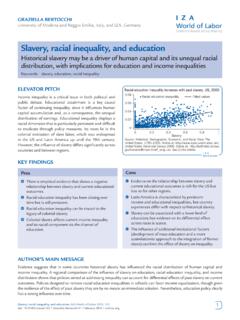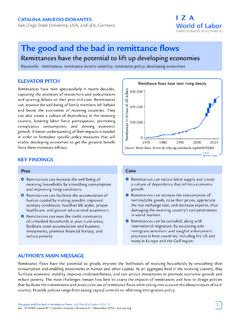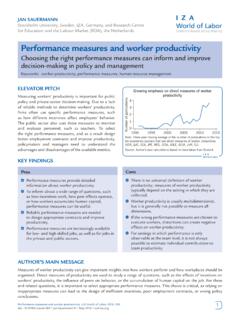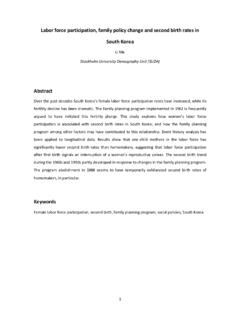Transcription of Female labor force participation in developing countries
1 Sher VerickInternational Labour Organization, India, and IZA, GermanyFemale labor force participation in developing countries . IZA World of labor 2014: 87doi: | Sher Verick | September 2014 | Pros Female labor force participation is an important driver (and outcome) of growth and development. Women join the workforce in developing countries as a coping mechanism in response to shocks. The participation of women is the outcome of various macro and individual factors. Access to quality education (beyond secondary) is critical to improve employment outcomes for PiTchWhile women s labor force participation tends to increase with economic development, the relationship is not straightforward or consistent at the country level. There is considerably more variation across developing countries in labor force participation by women than by men. This variation is driven by a wide variety of economic and social factors, which include economic growth, education, and social norms.
2 Looking more broadly at improving women s access to quality employment, a critical policy area is enhancing women s educational attainment beyond secondary S MAiN MeSSAGeThe relationship between women s participation in the labor force and development is complex and reflects changes in economic activity, educational attainment, fertility rates, social norms, and other factors. Standard labor force participation rates paint only a partial picture of women s work. More important is understanding the quality of women s employment. To achieve gains in employment quality, policies need to focus on both labor demand and supply dimensions. Expanding access to secondary and higher education is particularly In developing countries , high Female labor force participation rates typically reflect poverty. Women earn less than men and are more likely to be engaged in unprotected jobs, such as domestic work.
3 Education raises the reservation wage and expectations of women, but it needs to be matched by job creation. Underreporting is common, so data on women s participation rates do not accurately reflect women s labor force participation in developing countriesImproving employment outcomes for women takes more than raising labor market participation good jobs are important tooKeywords: Female labor force participation , developing countries , employmentkeY FiNDiNGS1009080706050403020100 INTRMXZAIDBRPEKHL abor force participation rate (%)Gender disparities in labor force participation ratesSource: Based on Figure World of labor | September 2014 | Verick | Female labor force participation in developing countries MOTiVATiONWomen s participation in the labor market varies greatly across countries , reflecting differences in economic development, social norms, education levels, fertility rates, and access to childcare and other supportive services (see Defining the labor force participation rate).
4 The relationship between Female labor force participation and these factors is complex. One dimension that has been widely examined is the U-shaped relationship between economic development and women s labor force participation (see What is the U-shaped hypothesis?) [1]. Focusing on these issues is critical because Female labor force participation is a driver of growth, and thus participation rates indicate a country s potential to grow more rapidly. It is also important because in many developing countries women s labor force participation is a coping mechanism in response to economic shocks that hit the household. However, beyond the numbers is the far more important concern with the quality of work that women are able to engage the labor force participation rateThe labor force participation rate is a measure of the proportion of a country s working-age population that engages actively in the labor market, either by working or by looking for work.
5 As the sum of the employed and (searching) unemployed, this indicator signals the relative size of the supply of labor available to engage in the production of goods and services (ILO Key Indicators of the Labour Market, 8th Edition. Online at: ).People are counted as a part of the labor force if they are engaged in activities that are included in the System of National Accounts or are available and searching for work in such are classified as not being in the labor force if they are attending an educational institution, engaged in household duties, retired, or infirm or disabled (and other reasons).What is the U-shaped hypothesis?The U-shaped hypothesis describes the correlation of the Female labor force participation rate with economic development (structural shifts in economic activity and changes to household labor supply and attitudes about women working outside the home). In its basic form, the hypothesis posits that Female participation rates are highest in poor countries , where women are engaged in subsistence activities, and fall in middle-income countries because of the transition of (mainly) men to industrial jobs.
6 As education levels improve and fertility rates fall, women are able to join the labor force in response to growing demand in the services sector. This is a stylized fact, but it is not robust to different data sets and econometric paper highlights the complex nature of Female labor force participation in developing countries and presents findings on the key trends and factors that drive women s engagement in the labor market and access to employment, especially the role of educational attainment. It examines specific insights from different developing countries , including Brazil, India, Indonesia, and Turkey. Above all, what comes through is the importance of looking at the quality of employment and the need to focus on promoting better outcomes for women in the labor World of labor | September 2014 | Verick | Female labor force participation in developing countries DiScUSSiON OF PrOS AND cONSD evelopment, as seen during the Industrial Revolution and more recently in East and (parts of ) Southeast Asia, has involved two related transitions: the movement of workers from agriculture to manufacturing (and more recently services) and the migration of people from rural to urban areas.
7 These transitions were associated with rising levels of education, declining fertility rates, and shifts in other socio-economic drivers of labor force participation , with specific implications for the role of women, especially in the labor labor supply is, therefore, both a driver and an outcome of development. As more women enter the labor force , economies can grow faster in response to higher labor inputs. At the same time, as countries develop, women s capabilities typically improve, while social constraints weaken, enabling women to engage in work outside the home. For this reason, policymakers need to understand the nature of women s labor supply and to monitor women s labor force participation . Ultimately, labor force participation is the outcome of not only supply-side factors, but also of the demand for relationship between evolving socio-economic and demographic factors and how women participate in the world of work is multifaceted.
8 In particular, whether a woman is working may be driven, on the one hand, by poverty (as evident in low-income countries ) and, on the other, by women s increasing educational attainment and the opportunities to work that are made available in a more modern economy. Moreover, during periods of crisis and in response to economic shocks, women are often required to take up (typically informal) employment to smooth household consumption. This occurred in Indonesia in the wake of the East Asian Financial Crisis of 1997 1998 [2].Beyond analyzing labor force participation , it is also important to look at the nature of women s employment. In general, when women work, they tend to be paid less and to be employed in low-productivity jobs. Educational attainment is a major driver of better employment outcomes for women in both developed and developing trends mask large differences in Female labor force participation ratesOver the last two decades, the global Female labor force participation rate has remained fairly stable, declining slightly for the total Female working-age population (15+) from in 1992 to in 2012 (based on ILO estimates, ).
9 Though million women have joined the labor market in the past 20 years, women still account for just of the global labor force . Moreover, the gap in participation rates of men and women has narrowed only slightly, from percentage points in 1992 to percentage points in 2012 (15+). However, as education enrollment rates have risen, participation rates have fallen among school-age youth (a positive trend). Looking at just the 25 and older age group and abstracting from the effect of rising enrollment in education reveals a rise in the global Female labor force participation rate, from in 1992 to in 2012. At the same time, the gender gap for the adult working-age population 25 and older has fallen from percentage points in 1992 to percentage points in a more disaggregated level, the participation of women varies considerably across developing countries and emerging market economies, far more than the participation of men.
10 In the Middle East, North Africa, and South Asia, less than 40% of women aged 25 and older participate in the labor force (Figure 1). However, participation rates have increased in IZA World of labor | September 2014 | Verick | Female labor force participation in developing countries Figure 1. Regional estimates of Female labor force participation rates, 1992 and 2012(adult population 25 and older) 8070605040302010019922012 Female labor forceparticipation rate (%)Middle EastNorth AfricaSouth AsiaLatin America &CaribbeanWorldSoutheast Asia &PacificSub-SaharanAfricaEast AsiaSource: ILO Key Indicators of the Labour Market, 8th Edition. Online at: Middle East and North Africa from 1992 to 2012, while they have fallen in South Asia. In all three regions, conservative social attitudes toward women in the work place prevail [3].But even within regions where overall Female labor force participation rates are low, there is considerable diversity (Figure 2).
